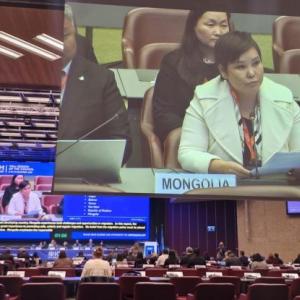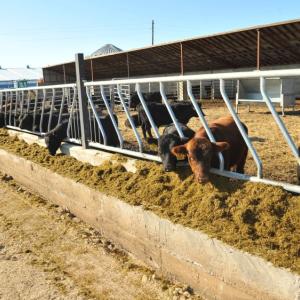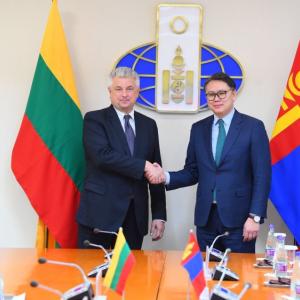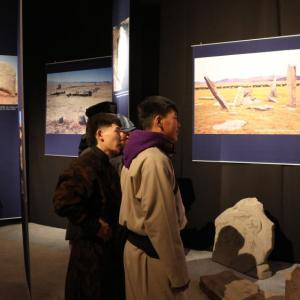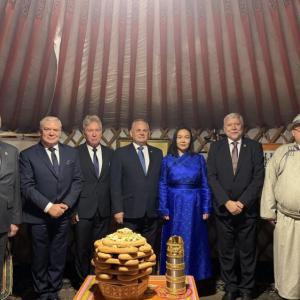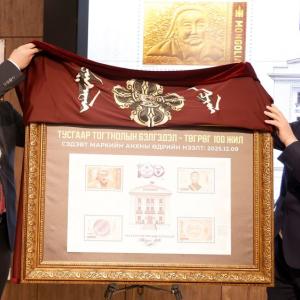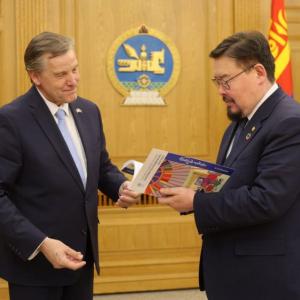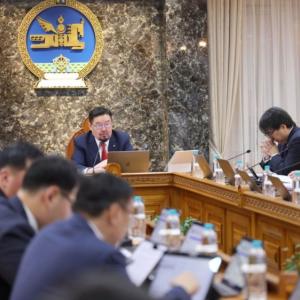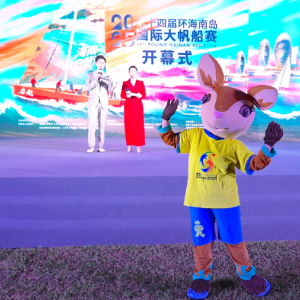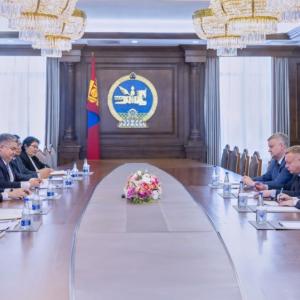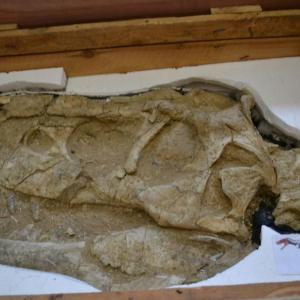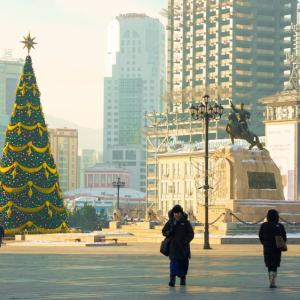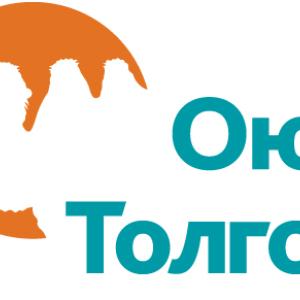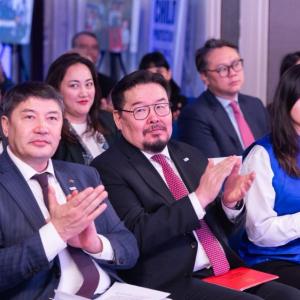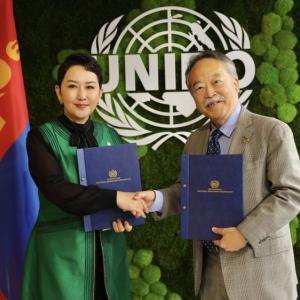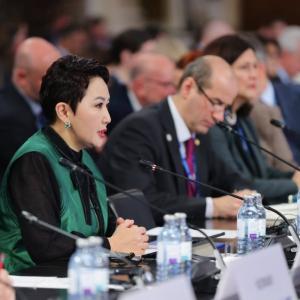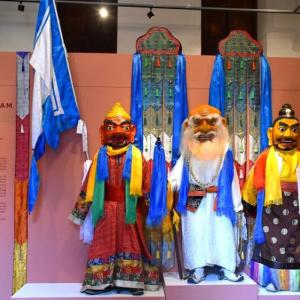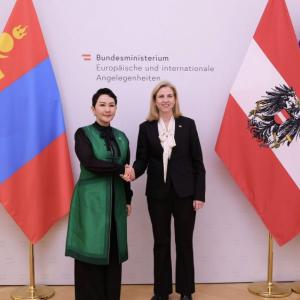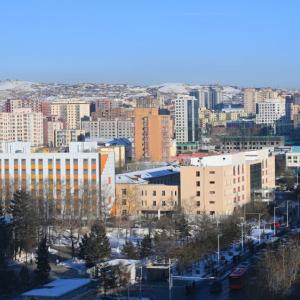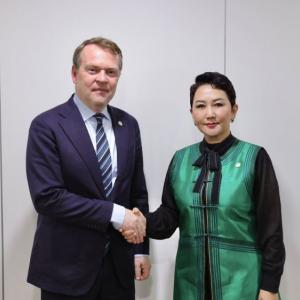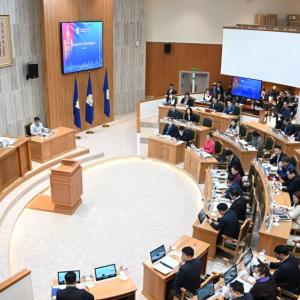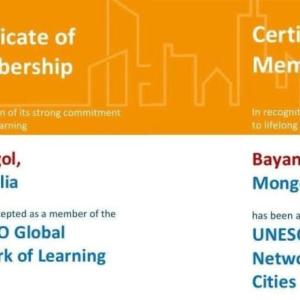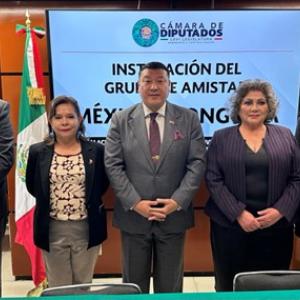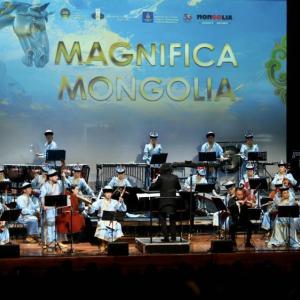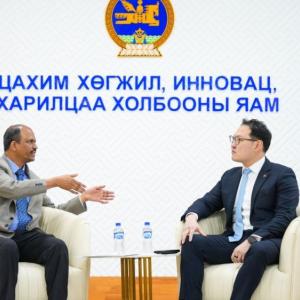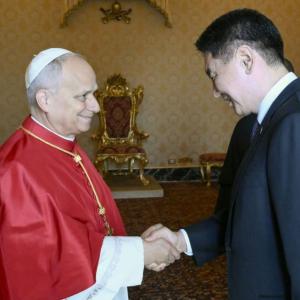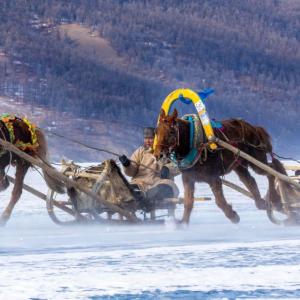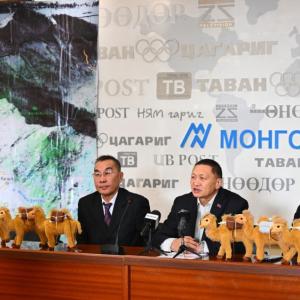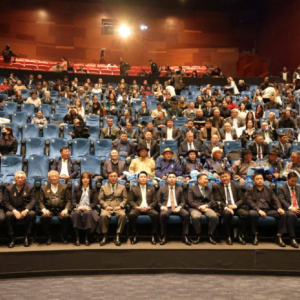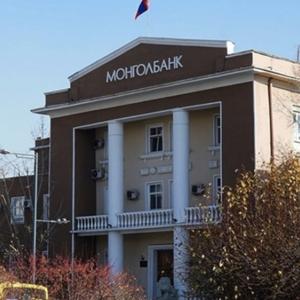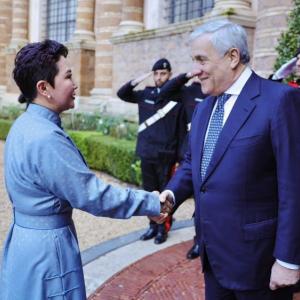The main representatives of Mongolia’s cultural heritage in UNESCO List
The Mongol MessengerFrom time immemorial, the Mongolian people have created its unique and amazing culture while making a valuable contribution to the development of the world culture. The Government of Mongolia is committed to take all possible steps to conserve, come by and advance the cultural heritage. One of the important actions in this direction is to register them in the lists of UNESCO Convention Concerning the Protection of the World Cultural and Natural Heritage.
Morin Khuur (horse head fiddle)
Morin khuur is a two-stringed musical instrument of Mongols. As a rule, Morin khuur is played by a male musician for both solo performance and accompaniment. Of a particular importance is accompaniment of long song singing and epic telling.
Morin khuur represents tradition, lifestyle and culture of the Mongolian people and is a big attribute of various fests, wedding and other different ceremonies and rituals of nomads. Long ago, a family which has a morin khuur is considered as a complete and vice versa. Morin khuur was placed in the UNESCO List of Cultural Heritage in 2003.
Mongolian version of Ganjuur
 The Mongolian version of the Ganjuur (translation of the Ganjuur into Mongolian language) is a canonical collection of Buddhist works. With 110 volumes the unique creation consists of a huge amount of works with different contents in prose and verses such as conversation of Gautama Buddha or Shakyamuni with his students about moral and philosophy and parables. The Ganjuur was translated from Tibetan into Mongolian during the period of Ligden Khaan ruling or between 1604 and 1634. The folio was created in Mongolia in 1819 with use of traditional nine jewels of Mongolians which are gold, silver, copper, pearl, lapis, turquoise, coral, mother of pearl and steel.
The Mongolian version of the Ganjuur (translation of the Ganjuur into Mongolian language) is a canonical collection of Buddhist works. With 110 volumes the unique creation consists of a huge amount of works with different contents in prose and verses such as conversation of Gautama Buddha or Shakyamuni with his students about moral and philosophy and parables. The Ganjuur was translated from Tibetan into Mongolian during the period of Ligden Khaan ruling or between 1604 and 1634. The folio was created in Mongolia in 1819 with use of traditional nine jewels of Mongolians which are gold, silver, copper, pearl, lapis, turquoise, coral, mother of pearl and steel.
It was in 2013 when the Mongolian version of the Ganjuur created with use of nine jewels was officially listed as a World Cultural Heritage by UNESCO.
Mongolian version of Danjuur
The Danjuur consists of comments to the Ganjuur, teachings and compositions on philosophy, linguistics, versification, medicine and architecture which are translated from Sanskrit. There are 254 volumes available in full versions with roughly 3.5 thousand texts. Widely spread in Mongolia is a version consisting of 225 volumes.
The Danjuur had influenced much on the Mongolian literature and a range of sciences progress. Created by ancient Indian and Tibetan scholars, the Danjuur represents a collection of 3427 works on ten subjects and is a good guidebook for translators.
It was acknowledged as a World Cultural Heritage in 2011.
Traditional craftsmanship of Mongol Ger and its associated customs
 Traditional dwelling of nomads – ger undoubtedly is comfortable and practical. Made of exclusively of natural materials, the ger is designed for lifestyle of nomads who move from one place to another all year round. Every part of the ger requires good craftsmanship and has close bond with the culture of the Mongolian people. There are many customs related to the construction of the ger, how to come in and out of the ger, and every furniture has its own position in ger.
Traditional dwelling of nomads – ger undoubtedly is comfortable and practical. Made of exclusively of natural materials, the ger is designed for lifestyle of nomads who move from one place to another all year round. Every part of the ger requires good craftsmanship and has close bond with the culture of the Mongolian people. There are many customs related to the construction of the ger, how to come in and out of the ger, and every furniture has its own position in ger.
Traditional craftsmanship of ger and its associated customs are placed in the List of Intangible Cultural Heritage of UNESCO.
Coaxing ritual for camels
 Camel has always played its own role in the lives of nomads. The coaxing ritual for female camel is performed to encourage it to accept a new-born calf or to adopt an orphan. The mother is tied close to the calf and a singer begins a monotone song accompanied by gestures and chanting. The coaxer changes the melody depending on the mother’s behavior, which may be initially aggressive, and slowly coaxes her into accepting the calf. The performance of the ritual requires great skill in handling camels, as well as talent for singing and musical skill on morin khuur or the horse head fiddle or flute. The ritual acts as a symbolic medium for creating and maintaining social ties among individual nomadic families and their community. Changes in the social and cultural environment, however, have negatively affected its viability. The number of cultural bearers is decreasing rapidly as new generations lose touch with their traditional ties to pastoral husbandry.
Camel has always played its own role in the lives of nomads. The coaxing ritual for female camel is performed to encourage it to accept a new-born calf or to adopt an orphan. The mother is tied close to the calf and a singer begins a monotone song accompanied by gestures and chanting. The coaxer changes the melody depending on the mother’s behavior, which may be initially aggressive, and slowly coaxes her into accepting the calf. The performance of the ritual requires great skill in handling camels, as well as talent for singing and musical skill on morin khuur or the horse head fiddle or flute. The ritual acts as a symbolic medium for creating and maintaining social ties among individual nomadic families and their community. Changes in the social and cultural environment, however, have negatively affected its viability. The number of cultural bearers is decreasing rapidly as new generations lose touch with their traditional ties to pastoral husbandry.
The ritual was inscribed on the List of Intangible Cultural Heritage in Need of Urgent Safeguarding in 2015.
Folk dance Biyelgee
 Regarded as the original forebear of Mongolian national dances, Biyelgee dances embody and originate from the nomadic way of life. Biyelgee dances are typically confined to the small space inside the ger (nomadic dwelling) and are performed while half sitting or cross-legged. Hand, shoulder and leg movements express aspects of Mongol lifestyle including household labour, customs and traditions, as well as spiritual characteristics tied to different ethnic groups. Biyelgee dancers wear clothing and accessories featuring colour combinations, artistic patterns, embroidery, knitting, quilting and leather techniques, and gold and silver jewellery specific to their ethnic group and community. The dances play a significant role in family and community events such as feasts, celebrations, weddings and labour-related practices, simultaneously expressing distinct ethnic identities and promoting family unity and mutual understanding among different Mongolian ethnic groups.
Regarded as the original forebear of Mongolian national dances, Biyelgee dances embody and originate from the nomadic way of life. Biyelgee dances are typically confined to the small space inside the ger (nomadic dwelling) and are performed while half sitting or cross-legged. Hand, shoulder and leg movements express aspects of Mongol lifestyle including household labour, customs and traditions, as well as spiritual characteristics tied to different ethnic groups. Biyelgee dancers wear clothing and accessories featuring colour combinations, artistic patterns, embroidery, knitting, quilting and leather techniques, and gold and silver jewellery specific to their ethnic group and community. The dances play a significant role in family and community events such as feasts, celebrations, weddings and labour-related practices, simultaneously expressing distinct ethnic identities and promoting family unity and mutual understanding among different Mongolian ethnic groups.
The Biyelgee dance was acknowledged by UNESCO as an intangible cultural heritage in 2009.
Mongolian tuuli – epic
 The Mongolian Tuuli is an oral tradition comprising heroic epics that run from hundreds to thousands of lines and combine benedictions, eulogies, spells, idiomatic phrases, fairy tales, myths and folk songs. They are regarded as a living encyclopedia of Mongolian oral traditions and immortalize the heroic history of the Mongolian people. Epic singers are distinguished by their prodigious memory and performance skills, combining singing, vocal improvisation and musical composition coupled with theatrical elements. Epic lyrics are performed to musical accompaniment on instruments such as the morin khuur (horse head fiddle) and tovshuur (lute). Epics are performed during many social and public events, including state affairs, weddings, a child’s first haircut, the Naadam and the worship of sacred sites. Epics evolved over many centuries, and reflect nomadic lifestyles, social behaviors, religion, mentalities and imagination.
The Mongolian Tuuli is an oral tradition comprising heroic epics that run from hundreds to thousands of lines and combine benedictions, eulogies, spells, idiomatic phrases, fairy tales, myths and folk songs. They are regarded as a living encyclopedia of Mongolian oral traditions and immortalize the heroic history of the Mongolian people. Epic singers are distinguished by their prodigious memory and performance skills, combining singing, vocal improvisation and musical composition coupled with theatrical elements. Epic lyrics are performed to musical accompaniment on instruments such as the morin khuur (horse head fiddle) and tovshuur (lute). Epics are performed during many social and public events, including state affairs, weddings, a child’s first haircut, the Naadam and the worship of sacred sites. Epics evolved over many centuries, and reflect nomadic lifestyles, social behaviors, religion, mentalities and imagination.
The Mongolian epic was inscribed on the List of Intangible Cultural Heritage in Need of Urgent Safeguarding in 2009.
Traditional music of tsuur
 Tsuur music is based on a combination of instrumental and vocal performance – a blending of sounds created simultaneously by both the musical instrument and the human throat. Tsuur music has an inseparable connection to the Uriankhai Mongolians of the Altai Region, and remains an integral part of their daily life. Its origins lie in an ancient practice of worshipping nature and its guardian spirits by emulating natural sounds. The Tsuur is a vertical pipe-shaped wooden wind instrument with three finger holes. Simultaneously touching the mouthpiece of the pipe with one’s front teeth and applying one’s throat produces a unique timbre comprising a clear and gentle whistling sound and a drone. The Tsuur is traditionally played to ensure success for hunts, for benign weather, as a benediction for safe journeys or for weddings and other festivities. The music reflects one’s inner feelings when travelling alone, connects a human to nature, and serves as a performing art.
Tsuur music is based on a combination of instrumental and vocal performance – a blending of sounds created simultaneously by both the musical instrument and the human throat. Tsuur music has an inseparable connection to the Uriankhai Mongolians of the Altai Region, and remains an integral part of their daily life. Its origins lie in an ancient practice of worshipping nature and its guardian spirits by emulating natural sounds. The Tsuur is a vertical pipe-shaped wooden wind instrument with three finger holes. Simultaneously touching the mouthpiece of the pipe with one’s front teeth and applying one’s throat produces a unique timbre comprising a clear and gentle whistling sound and a drone. The Tsuur is traditionally played to ensure success for hunts, for benign weather, as a benediction for safe journeys or for weddings and other festivities. The music reflects one’s inner feelings when travelling alone, connects a human to nature, and serves as a performing art.
The music of tsuur was placed on the List of Intangible Cultural Heritage in Need of Urgent Safeguarding in 2009.
Folk long song performance technique of Limbe performances - circular breathing
 The Limbe is a side-blown flute of hardwood or bamboo, traditionally used to perform Mongolian folk long songs. Through the use of circular breathing, Limbe performers are able to produce the continuous, wide-ranging melodies characteristic of the long song. Players breathe in through the nose while simultaneously blowing out through the mouth, using air stored in their cheeks to play the flute without interruption. Single stanzas of folk long song last approximately four to five minutes. A single song consists of three to five or more stanzas, which requires performance of the flute to continue uninterrupted for twelve to twenty-five minutes. Traditional training methods used to acquire this technique include continuously blowing at a candle flame without extinguishing it and blowing through a straw into a glass of water. Limbe playing is characterized by euphonious melodies, melisma, hidden tunes and skilful and delicate movements of the fingers and tongue.
The Limbe is a side-blown flute of hardwood or bamboo, traditionally used to perform Mongolian folk long songs. Through the use of circular breathing, Limbe performers are able to produce the continuous, wide-ranging melodies characteristic of the long song. Players breathe in through the nose while simultaneously blowing out through the mouth, using air stored in their cheeks to play the flute without interruption. Single stanzas of folk long song last approximately four to five minutes. A single song consists of three to five or more stanzas, which requires performance of the flute to continue uninterrupted for twelve to twenty-five minutes. Traditional training methods used to acquire this technique include continuously blowing at a candle flame without extinguishing it and blowing through a straw into a glass of water. Limbe playing is characterized by euphonious melodies, melisma, hidden tunes and skilful and delicate movements of the fingers and tongue.
The technique of limbe performance was inscribed on the List of Intangible Cultural Heritage in Need of Urgent Safeguarding in 2011.
Long song – peak of the Mongolian vocal art
 The urtiin duu or folk long song is a miraculous unmatched phenomenon in the world folklore. Its performance is as complicate as it is magnificent. It requires from a singer perfect vocal technique, powerful voice and improvised talent. Urtiin duu is a lyrical chant made of 32 verses with a highly ornamented melody praising the beauty of the steppe, mountains and rivers, the love for parents or close friends, expressing reflections on human destiny. It is characterized by an abundance of ornamentation, falsetto, a long and continuously flowing melody with rich rhythmical variation, an extremely wide vocal range and a free compositional form. The rising melody is slow and steady while the falling melody is often intercepted with a lively triple continuant, imitating the pace of life in the grasslands.
The urtiin duu or folk long song is a miraculous unmatched phenomenon in the world folklore. Its performance is as complicate as it is magnificent. It requires from a singer perfect vocal technique, powerful voice and improvised talent. Urtiin duu is a lyrical chant made of 32 verses with a highly ornamented melody praising the beauty of the steppe, mountains and rivers, the love for parents or close friends, expressing reflections on human destiny. It is characterized by an abundance of ornamentation, falsetto, a long and continuously flowing melody with rich rhythmical variation, an extremely wide vocal range and a free compositional form. The rising melody is slow and steady while the falling melody is often intercepted with a lively triple continuant, imitating the pace of life in the grasslands.
In 2005, the Urtiin duu was proclaimed as a masterpiece of the Oral and Intangible Heritage of Humanity.
Mongolian calligraphy
 Mongolian calligraphy is the technique of handwriting in the classical Mongolian script, which comprises ninety letters connected vertically by continuous strokes to create words. The letters are formed from six main strokes, known as head, tooth, stem, stomach, bow and tail, respectively. This meticulous writing is used for official letters, invitations, diplomatic correspondence and love letters; for a form of shorthand known as synchronic writing; and for emblems, logos, coins and stamps in ‘folded’ forms.
Mongolian calligraphy is the technique of handwriting in the classical Mongolian script, which comprises ninety letters connected vertically by continuous strokes to create words. The letters are formed from six main strokes, known as head, tooth, stem, stomach, bow and tail, respectively. This meticulous writing is used for official letters, invitations, diplomatic correspondence and love letters; for a form of shorthand known as synchronic writing; and for emblems, logos, coins and stamps in ‘folded’ forms.
The Mongolian traditional script is the only vertical script in the world which is written from up to down clockwise.
Mongolian calligraphy was inscribed on the List of Intangible Cultural Heritage in Need of Urgent Safeguarding in 2013.
Mongolian knuckle-bone shooting
 Mongolians revere certain parts of bones of their domestic livestock and use them in religious rites, plays and traditional games. One such popular team-based game is knuckle-bone shooting. Teams of six to eight only male players flick thirty domino-like marble tablets on a smooth wooden surface towards a target of sheep knuckle-bones, aiming to knock them into a target zone, while shooters sing traditional knuckle-bone shooting melodies and songs. Each shooter possesses individually crafted shooting tools and instruments, and wears costumes embossed with distinguished characteristics depending on their rank and merits.
Mongolians revere certain parts of bones of their domestic livestock and use them in religious rites, plays and traditional games. One such popular team-based game is knuckle-bone shooting. Teams of six to eight only male players flick thirty domino-like marble tablets on a smooth wooden surface towards a target of sheep knuckle-bones, aiming to knock them into a target zone, while shooters sing traditional knuckle-bone shooting melodies and songs. Each shooter possesses individually crafted shooting tools and instruments, and wears costumes embossed with distinguished characteristics depending on their rank and merits.
There are only about 6000 knuckle-bone shooters in Mongolia.
The knuckle-bone shooting has been on the List of Intangible Cultural Heritage since 2014.
Sutra Great Deity Tara
The Sutra Great Deity Tara from Mongolia has been inscribed in the Asia-Pacific Register of the Memory of the World in 2014.
The Sutra Great Deity Tara is a miniature book contains 79 handwritten lines of religious text often used by Mongolians for prayers. It was created by the Buddhist lama Shagj Sangajav in 1914, Measuring just 4.9 cm by 5.4 cm, the sutra of the Green and White Tara is considered as one of the smallest manuscripts in Mongolian history, and showcases the country’s socio-cultural changes over the years.
The unique work consists of 62 strophe poems, 250 lines, 5718 alpha characters, 2510 lines in a verse, and a total of 8228 characters in Tibetan language. In the Sutra, the White and Green Tara was written each in red and black in with its different abstraction.
Naadam traditional festival
 Naadam is a national festival celebrated every year in month of July across Mongolia that focuses on three traditional games: horseracing, wrestling and archery. Oral traditions, performing arts, national cuisine, craftsmanship, and cultural forms such as long song, khoomii overtone singing, biyelgee dance and morin khuur also feature prominently during Naadam. Mongolians follow special rituals and practices during the festival, such as wearing unique costumes and using distinctive tools and sporting items. Festival participants revere the sportsmen, sportswomen, and children who compete, and winners are rewarded titles for their achievements. Ritual praise songs and poems are dedicated to the contestants in the events. The rituals and customs of Naadam also accentuate respect for nature and the environment.
Naadam is a national festival celebrated every year in month of July across Mongolia that focuses on three traditional games: horseracing, wrestling and archery. Oral traditions, performing arts, national cuisine, craftsmanship, and cultural forms such as long song, khoomii overtone singing, biyelgee dance and morin khuur also feature prominently during Naadam. Mongolians follow special rituals and practices during the festival, such as wearing unique costumes and using distinctive tools and sporting items. Festival participants revere the sportsmen, sportswomen, and children who compete, and winners are rewarded titles for their achievements. Ritual praise songs and poems are dedicated to the contestants in the events. The rituals and customs of Naadam also accentuate respect for nature and the environment.
The Naadam traditional festival was acknowledged as an Intangible Cultural Heritage of Humanity in 2010.
Art of singing – khoomei
 Khoomei is a form of singing originating in western Mongolia, in the Altai mountains. The performer imitates sounds of nature, simultaneously emitting two distinct vocal sounds: along with a continuous drone, the singer produces a melody of harmonics. Khoomei literally means pharynx, and it is believed to have been learned from birds, whose spirits are central to shamanic practices. The multitude of Khoomei techniques in Mongolia are grouped within two main styles: the ''kharkhiraa'' (deep Khoomei) and ''isgeree'' Khöömei (whistled Khoomei). In ''kharkhiraa'' the singer sings a drone in a normal voice, while emphasizing the undertone or subharmonic one octave below. In ''isgeree'' Khoomei, it is the overtones above the fundamental note of the drone that are emphasized, creating a higher-pitched whistle. In both cases, the drone is produced with very taut vocal cords, and the melody is created by modulating the size and shape of the mouth cavity, opening and closing the lips and moving the tongue. Khöömei is performed by Mongolian nomads in a variety of social occasions, from grand state ceremonies to festive household events. Khoomei is also sung during herding, and inside the yurt to lull babies to sleep.
Khoomei is a form of singing originating in western Mongolia, in the Altai mountains. The performer imitates sounds of nature, simultaneously emitting two distinct vocal sounds: along with a continuous drone, the singer produces a melody of harmonics. Khoomei literally means pharynx, and it is believed to have been learned from birds, whose spirits are central to shamanic practices. The multitude of Khoomei techniques in Mongolia are grouped within two main styles: the ''kharkhiraa'' (deep Khoomei) and ''isgeree'' Khöömei (whistled Khoomei). In ''kharkhiraa'' the singer sings a drone in a normal voice, while emphasizing the undertone or subharmonic one octave below. In ''isgeree'' Khoomei, it is the overtones above the fundamental note of the drone that are emphasized, creating a higher-pitched whistle. In both cases, the drone is produced with very taut vocal cords, and the melody is created by modulating the size and shape of the mouth cavity, opening and closing the lips and moving the tongue. Khöömei is performed by Mongolian nomads in a variety of social occasions, from grand state ceremonies to festive household events. Khoomei is also sung during herding, and inside the yurt to lull babies to sleep.
The khoomei art of singing has been on the List of Intangible Cultural Heritage since 2010.
Eagle hunting
 Eagle hunting is the traditional activity of keeping and training eagles to take quarry in its natural state. Originally a way of obtaining food, eagle hunting is today identified with camaraderie and sharing rather than subsistence. Eagle hunting is found in Bayan-Ulgii aimag and is practiced by Kazakh people of all ages and mainly men. Eagle hunters develop a strong relationship and spiritual bond with their birds, and commitment is required to breed, train, handle and fly the eagles. Eagle hunting forms the basis of a wider cultural heritage, including traditional dress, food, songs, music, poetry and dance, sustained by the communities and clubs that practice it.
Eagle hunting is the traditional activity of keeping and training eagles to take quarry in its natural state. Originally a way of obtaining food, eagle hunting is today identified with camaraderie and sharing rather than subsistence. Eagle hunting is found in Bayan-Ulgii aimag and is practiced by Kazakh people of all ages and mainly men. Eagle hunters develop a strong relationship and spiritual bond with their birds, and commitment is required to breed, train, handle and fly the eagles. Eagle hunting forms the basis of a wider cultural heritage, including traditional dress, food, songs, music, poetry and dance, sustained by the communities and clubs that practice it.
Eagle hunting or falconry was placed on the List of Intangible Cultural Heritage of Humanity in 2010.
Uvs Nuur Basin
 The Uvs Nuur Basin (1,068,853 ha), is a quite large in Mongolia saline and shallow lake situated on the northwestern part of Mongolia. The steppe ecosystem supports a rich diversity of birds and the desert is home to a number of rare gerbil, jerboas and the marbled polecat. The mountains are an important refuge for the globally endangered snow leopard, mountain sheep (argali) and the Asiatic ibex.
The Uvs Nuur Basin (1,068,853 ha), is a quite large in Mongolia saline and shallow lake situated on the northwestern part of Mongolia. The steppe ecosystem supports a rich diversity of birds and the desert is home to a number of rare gerbil, jerboas and the marbled polecat. The mountains are an important refuge for the globally endangered snow leopard, mountain sheep (argali) and the Asiatic ibex.
The property contains remnant glaciers from Pleistocene ice sheets and numerous glacial lakes, and is of particular scientific significance for studying the evolution from the Ice Age to present-day conditions. The historical, cultural and spiritual importance of the landscape and many of its features are reflected in countless artifacts and archaeological sites and in the contemporary life, knowledge, resource use, songs and legends of local and indigenous communities.
The Uvs Nuur Basin has been on the List of World Cultural and Natural Heritage since 2003.
Orkhon Valley Cultural Landscape
 The Orkhon Valley Cultural Landscape (OVCL) lies in the central part of Mongolia, some 360 km southwest of Ulaanbaatar. The site covers 121,967 ha of grassland along the historic Orkhon River. Over successive centuries, the Orkhon Valley was found very suitable for settlement by waves of nomadic people. The earliest evidence of human occupancy dates from the sites of Moiltyn Am (40,000- 15,000 years ago) and “Orkhon-7” which show that the Valley was first settled about 62,000-58,000 years ago. Subsequently the Valley was continuously occupied throughout the Prehistoric and Bronze ages and in proto-historic and early historic times was settled successively by the Huns, Turkic peoples, the Uighurs, the Kidans, and finally the Mongols.
The Orkhon Valley Cultural Landscape (OVCL) lies in the central part of Mongolia, some 360 km southwest of Ulaanbaatar. The site covers 121,967 ha of grassland along the historic Orkhon River. Over successive centuries, the Orkhon Valley was found very suitable for settlement by waves of nomadic people. The earliest evidence of human occupancy dates from the sites of Moiltyn Am (40,000- 15,000 years ago) and “Orkhon-7” which show that the Valley was first settled about 62,000-58,000 years ago. Subsequently the Valley was continuously occupied throughout the Prehistoric and Bronze ages and in proto-historic and early historic times was settled successively by the Huns, Turkic peoples, the Uighurs, the Kidans, and finally the Mongols.
At the height of its cultural ascendancy, the inscribed property was the site of historic Kharakhorum – the grand capital of the vast Mongol Empire established by Chinggis Khaan in 1220.
Within the cultural landscape are a number of archaeological remains and standing structures, including Turkish memorial sites of the 6th-7th centuries, the 8th9th centuries’ Uighur capital of Khar Balgas as well as the 13th-14th centuries’ ancient Mongol imperial capital of Kharakhorum. Erdene Zuu, the earliest surviving Mongol Buddhist monastery, the Tuvkhun Hermitage and the Shank Western monastery are testimony to the widespread and enduring religious traditions and cultural practices of the Northern School of Buddhism which, with their respect for all the forms of life, enshrine the enduring sustainable management practices of this unique cultural landscape of the Central Asian steppes.
The Orkhon Valley Cultural Landscape was inscribed on the List of World Heritage in 2004.
Great Burkhan Khaldun Mountain and its surrounding sacred landscape
 The site is situated in the north-east of the country in the central part of the Khentii mountain chain where the vast Central Asian steppe meets the coniferous forests of the Siberian taiga. Burkhan Khaldun is associated with the worship of sacred mountains, rivers and ovoo-s (rock cairns), in which ceremonies have been shaped by a fusion of ancient shamanic and Buddhist practices. The site is also believed to be the place of Chinggis Khaan’s birth and burial. It testifies to his efforts to establish mountain worship as an important part of the unification of the Mongol people. Vicinity of the sacred mountain is home to various historical monuments, petroglyphs and ancient burials.
The site is situated in the north-east of the country in the central part of the Khentii mountain chain where the vast Central Asian steppe meets the coniferous forests of the Siberian taiga. Burkhan Khaldun is associated with the worship of sacred mountains, rivers and ovoo-s (rock cairns), in which ceremonies have been shaped by a fusion of ancient shamanic and Buddhist practices. The site is also believed to be the place of Chinggis Khaan’s birth and burial. It testifies to his efforts to establish mountain worship as an important part of the unification of the Mongol people. Vicinity of the sacred mountain is home to various historical monuments, petroglyphs and ancient burials.
Great Burkhan Khalduun Mountain and its surrounding sacred landscape were recognized as World Heritage in 2015.
Petroglyphic Complexes of the Mongolian Altai
 The Petroglyphic Complexes of the Mongolian Altai include three rock art sites in Bayan-Ulgii aimag: Tsagaan Salaa-Baga Oigor of Ulaankhus soum, and Upper Tsagaan Gol (Shiveet Khairkhan) and Aral Tolgoi, both of Tsengel soum. All three are located in high mountain valleys carved out by Pleistocene glaciers. These three property components include large concentrations of petroglyphs and funerary and ritual monuments reflecting the development of human culture over a period of 12,000 years. The earliest images reflect a period beginning in the Late Pleistocene and lasting through the Early Holocene (ca. 11,000 – 6,000 years BP), when the paleoenvironment shifted from dry to forested steppe and the valleys provided an ideal habitat for hunters of large wild game. Later images from the middle Holocene (ca. 6,000 – 4,000 years BP) reflect the gradual reassertion of steppe vegetation in this part of the the Altai and the early emergence of herding as the economic basis of communities. Imagery from the succeeding, Late Holocene Period, reflects the transition to horse-dependent nomadism during the Early Nomadic and Scythian periods (1st millennium BCE) and the subsequent spread of steppe empires in the later Turkic Period (7th-9th c. CE).
The Petroglyphic Complexes of the Mongolian Altai include three rock art sites in Bayan-Ulgii aimag: Tsagaan Salaa-Baga Oigor of Ulaankhus soum, and Upper Tsagaan Gol (Shiveet Khairkhan) and Aral Tolgoi, both of Tsengel soum. All three are located in high mountain valleys carved out by Pleistocene glaciers. These three property components include large concentrations of petroglyphs and funerary and ritual monuments reflecting the development of human culture over a period of 12,000 years. The earliest images reflect a period beginning in the Late Pleistocene and lasting through the Early Holocene (ca. 11,000 – 6,000 years BP), when the paleoenvironment shifted from dry to forested steppe and the valleys provided an ideal habitat for hunters of large wild game. Later images from the middle Holocene (ca. 6,000 – 4,000 years BP) reflect the gradual reassertion of steppe vegetation in this part of the the Altai and the early emergence of herding as the economic basis of communities. Imagery from the succeeding, Late Holocene Period, reflects the transition to horse-dependent nomadism during the Early Nomadic and Scythian periods (1st millennium BCE) and the subsequent spread of steppe empires in the later Turkic Period (7th-9th c. CE).
The Petroglyphic Complexes of the Mongolian Altai represent the most complete and best preserved visual record of human prehistory and early history of a region at the intersection of Central and North Asia.
The Petroglyphic Complex of Mongolian Altai has been on the List of World Heritage since 2011.
The list was featured in the Mongol Messenger's issue for January 22, 2016 No.3-4.
 Ulaanbaatar
Ulaanbaatar





